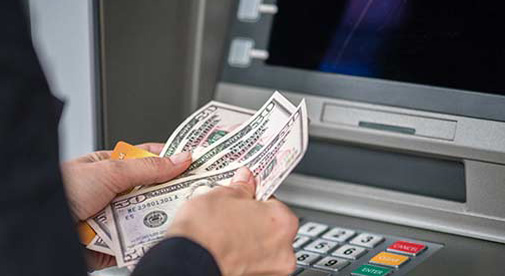There is something intoxicating about being in a new part of the world, experiencing a different way of doing things, eating food you didn’t know existed, and, of course, enjoying a generous share of the local liquor. Traveling is about letting go of your worries and embracing new experiences wholeheartedly.
However, even when you’re having the time of your life, it’s important not to lose sight of practical concerns entirely. You might not know it, but financial services often add a hidden “tax” on tourists who splash around more money than sense. If you’re not careful to watch out for these hidden charges, your trip could cost you hundreds of dollars more than you bargained for.
The good news is that these hidden charges are easy to avoid once you know what you’re doing.
ATM Strategy Abroad
ATMs are a major culprit when it comes to overcharging tourists. One example are Euronet machines, which are ubiquitous across Europe. They pop up in hotels, airports, souvenir shops, convenience stores, and on any street where tourists are commonplace. But they can be a huge rip-off in two ways.
Rip-off #1:
When you insert your U.S. debit card (or a debit card from any country other than the country you’re traveling in), these ATMs are programmed to initially offer withdrawal amounts that are insanely large. In Prague, where I currently live, I’ve seen these machines offer withdrawal amounts of between 10,000 and 20,000 Czech crowns. In dollar terms, that’s the equivalent of $440 and $880. Seriously, how often are you hitting up the ATM for that kind of cash?
The reason this ATM wants you to take out so much money is…
Rip-off #2:
Euronet offers hideous exchange rates. The more dollars this ATM gets you to convert, the more dollars it has to profit from the spread between the official exchange rate, which banks and institutions use, and the exchange rate Euronet offers you.
When I put the Euronet ATM to the test in Prague, it offered me 22.65 Czech crowns per euro at a moment the official exchange rate was 25.62. So, Euronet is taking an extra 12% from you. Across a $440 to $880 withdrawal, you’re looking at a hidden cost of between about $57 and $115.
The better strategy: Find ATMs attached to local banks. You’ll get much better exchange rates.
But even with bank ATMs there’s a strategy to prevent extra charges: Always reject the currency conversion shown on the screen. That’s typically a bad exchange rate.
I recently stopped by a Raiffeisen bank here in Prague to withdraw 1,000 crowns from my German euro account. On the ATM screen, Raiffeisen asked me to accept the transaction with a conversion rate of 23.99 crowns per euro, for a total withdrawal of €41.69 from my account.
I chose the option to “accept without conversion.” I got my 1,000 crowns, but it only cost me €39.06—an exchange rate of 25.60 crowns per euro, almost identical to the official exchange rate. That saved me from a hidden cost of almost 7%.
If you’re forced to use a Euronet machine, or any ATM not attached to a local bank, always select “Different Amount” if the quantities offered on screen are excessively high. That’s a sure sign you’re about to get ripped off. Then, withdraw as little as possible to see you through until you find a real bank ATM.
Credit Card Strategy Abroad
With credit cards, the strategy is to always choose the local currency option, when given a choice.
For instance, when I pop into local restaurants and pay with my credit card, or into a supermarket to pay with my debit card, the card-reader typically displays a message: CZK or EUR. It’s giving me the choice to select the “cancel” button to pay in Czech crowns or the “enter” button to pay in euros. I always push “cancel.”
By selecting the local currency, the credit or debit card company handles the currency conversion at, or near, the official exchange rate. If you select the option for dollars (or euros, in my case), the merchant does the currency conversion, and you can bet that’s never to your advantage.
Finally, get yourself a credit card that changes no foreign transaction fees.
Lots of cards today offer that feature, and maybe yours already does. But if it doesn’t, then signing up for such a card can save you a meaningful amount of money. Credit cards that do charge foreign transaction fees typically hit each of your purchases with an extra 3% upcharge.
Two top-notch credit cards to consider that offer no foreign transaction fees are: Capital One Quicksilver Cash Rewards and Bank of America Travel Rewards. There are many others, but these two not only impose no foreign transaction fees, neither impose an annual fee either.
RewardExpert.com found that the average cost of a four-day, international vacation is $3,538 per person. Consider what this might amount to if you’re paying 3% worth of hidden charges on every purchase you make on vacation.
When you’re spending multiple thousands of dollars overseas, having the right kind of credit card, and knowing the right strategies for paying with your credit card and withdrawing from ATMs can easily save you hundreds of dollars or more on your trip.
Related Articles
The Cheapest Places in the World to Live
The World’s Best Places to Retire
6 Great Places to Retire Where it’s Easy to Fit In
Upcoming Conferences
The Only 2024 Fast Track Panama Conference
If your dream retirement involves stunning beaches… lush green mountains… a warm climate with no hurricanes… first-rate healthcare… incredible value for money (a couple can live well on $2,200 a month)… and the World’s #1 Retiree Discount Program…
Join our Panama experts and expats in February and discover why Panama could be your perfect paradise.



.png)